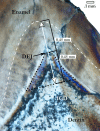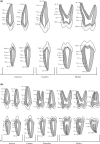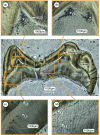Using teeth as tools: Investigating the mother-infant dyad and developmental origins of health and disease hypothesis using vitamin D deficiency
- PMID: 31709512
- PMCID: PMC7004071
- DOI: 10.1002/ajpa.23947
Using teeth as tools: Investigating the mother-infant dyad and developmental origins of health and disease hypothesis using vitamin D deficiency
Erratum in
-
Corrigendum: Using Teeth as Tools: Investigating the Mother-Infant Dyad and Developmental Origins of Health and Disease Hypothesis using Vitamin D Deficiency.Am J Phys Anthropol. 2021 Aug;175(4):948. doi: 10.1002/ajpa.24292. Epub 2021 May 11. Am J Phys Anthropol. 2021. PMID: 33973226 Free PMC article. No abstract available.
Abstract
Objectives: With a growing interest in the mother-infant dyad and the Developmental Origins of Health and Disease hypothesis among biological and medical anthropologists, this study set out to provide all the information required to evaluate if mineralization defects in dentine might be caused by vitamin D deficiency in the critical first 1000 days of life.
Materials and methods: Information was compiled on dentine formation in utero to approximately 18 years, and a method for determining the location of the neonatal line in dentine was devised, allowing the assessment of the prenatal and early life period. Re-evaluation of previously analyzed teeth (n = 61) was undertaken with detailed examination of n = 5/22 first permanent molars forming in the prenatal and critical early life periods.
Results: First permanent molars and all deciduous teeth give information on intrauterine development and on the first 1000 days postnatally providing a direct window on maternal and fetal health. Three archaeological individuals had interglobular dentine that formed prenatally suggesting that their mothers experienced vitamin D deficiency at the time dentine was forming and all other individuals had a deficiency during the first 1000 days of life. Conditions that could cause systemic mineralization defects were determined, and in each, case they were found to be consistent with vitamin D deficiency.
Discussion: The neonatal line serves as a clear baseline for determining prenatal and postnatal events, particularly those related to vitamin D, calcium, and phosphate metabolism, and can be used to investigate the maternal-infant dyad for both past and present communities.
Keywords: interglobular dentine; maternal health; neonatal line; prenatal vitamin D deficiency.
© 2019 The Authors. American Journal of Physical Anthropology published by Wiley Periodicals, Inc.
Figures




Similar articles
-
Interglobular dentine attributed to vitamin D deficiency visible in cremated human teeth.Sci Rep. 2021 Oct 25;11(1):20958. doi: 10.1038/s41598-021-00380-w. Sci Rep. 2021. PMID: 34697324 Free PMC article.
-
Micro-CT assessment of dental mineralization defects indicative of vitamin D deficiency in two 17th-19th century Dutch communities.Am J Phys Anthropol. 2019 May;169(1):122-131. doi: 10.1002/ajpa.23819. Epub 2019 Mar 18. Am J Phys Anthropol. 2019. PMID: 30882907 Free PMC article.
-
Heterogeneity in experiences of vitamin D deficiency in an early to mid-19th century population from Montreal, Quebec.Int J Paleopathol. 2024 Dec;47:1-11. doi: 10.1016/j.ijpp.2024.07.003. Epub 2024 Aug 14. Int J Paleopathol. 2024. PMID: 39146828
-
The rachitic tooth: Refining the use of interglobular dentine in diagnosing vitamin D deficiency.Int J Paleopathol. 2018 Sep;22:101-108. doi: 10.1016/j.ijpp.2018.07.001. Epub 2018 Jul 23. Int J Paleopathol. 2018. PMID: 30048808 Review.
-
The role of vitamin D in pregnancy and lactation: insights from animal models and clinical studies.Annu Rev Nutr. 2012 Aug 21;32:97-123. doi: 10.1146/annurev-nutr-071811-150742. Epub 2012 Apr 5. Annu Rev Nutr. 2012. PMID: 22483092 Review.
Cited by
-
Vitamin D status in post-medieval Northern England: Insights from dental histology and enamel peptide analysis at Coach Lane, North Shields (AD 1711-1857).PLoS One. 2024 Jan 31;19(1):e0296203. doi: 10.1371/journal.pone.0296203. eCollection 2024. PLoS One. 2024. PMID: 38295005 Free PMC article.
-
Integrated multidisciplinary analysis of mobile digital radiographic acquisitions of the mummies of the hermits from the Sanctuary of Madonna della Corona (Trentino-Alto Adige, Italy - 17th to 19th century CE).Front Med (Lausanne). 2025 Jan 15;11:1492328. doi: 10.3389/fmed.2024.1492328. eCollection 2024. Front Med (Lausanne). 2025. PMID: 39882513 Free PMC article.
-
Interglobular dentine attributed to vitamin D deficiency visible in cremated human teeth.Sci Rep. 2021 Oct 25;11(1):20958. doi: 10.1038/s41598-021-00380-w. Sci Rep. 2021. PMID: 34697324 Free PMC article.
-
Cortisol in deciduous tooth tissues: A potential metric for assessing stress exposure in archaeological and living populations.Int J Paleopathol. 2023 Dec;43:1-6. doi: 10.1016/j.ijpp.2023.08.001. Epub 2023 Aug 26. Int J Paleopathol. 2023. PMID: 37639895 Free PMC article.
-
Tracking breastfeeding and weaning practices in ancient populations by combining carbon, nitrogen and oxygen stable isotopes from multiple non-adult tissues.PLoS One. 2022 Feb 2;17(2):e0262435. doi: 10.1371/journal.pone.0262435. eCollection 2022. PLoS One. 2022. PMID: 35108296 Free PMC article.
References
-
- AlQahtani, S. J. (2008). Atlas of tooth development and eruption In Barts and the London School of Medicine and Dentistry. London, England: Queen Mary University of London.
-
- Ardissino, G. , Dacco, V. , Testa, S. , Bonaudo, R. , Claris‐Appiani, A. , Taioli, E. , … Sereni, F. (2003). Epidemiology of chronic renal failure in children: data from the ItalKid project. Pediatrics, 111(4), e382–e387. - PubMed
-
- Avery, J. K. (2002). Development of teeth and supporting structures In Oral Development and Histology (4th ed., pp. 95–106). New York, NY: Thieme Medical Publishers.
Publication types
MeSH terms
Grants and funding
- #29497/Ontario Research Fund Research Infrastructure (ORF-RI)/International
- Canada Foundation for Innovation John R. Evans Leaders Fund (CFI-JELF)/International
- N/A/Ontario Graduate Scholarship/International
- 767-2013-2678/SSHRC-CGS/International
- 231563/The Canada Research Chairs program/International
LinkOut - more resources
Full Text Sources
Medical
Miscellaneous

